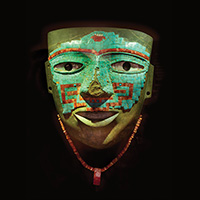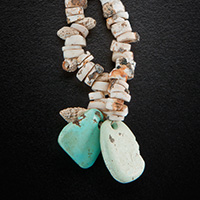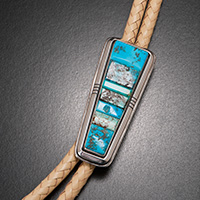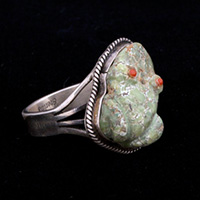Southwest Traditions:
Depression-Era Mosaics
Turquoise mosaics date back almost two thousand years in the Southwest. The technique was originally used by the Hohokam in southeastern Arizona, and later at Chaco Canyon and elsewhere by the Ancestral Pueblo. Chip-mosaic inlay is a thrifty variant, made with irregularly-shaped, small pieces of turquoise and other stone.
Santo Domingo Pueblo artists and those from nearby pueblos are well known for using the technique to adorn jewelry, especially necklaces. During the early 1900s when many mines were closed and turquoise was hard to acquire, the use of small pieces in inlay allowed artists to continue to make objects for internal consumption and for sale.
The use of non-traditional materials became common during the Depression Era, when plastics from battery casings, phonograph records, toothbrushes, and combs were incorporated into jewelry.
“Thunderbird” necklaces are a variant of the squash-blossom form and are treasured today for their creativity and lively design.
During a period when materials may have been difficult to acquire, jewelers at Santo Domingo began using available materials, including battery casings and old phonograph records for the backing, bone for beads, and turquoise and plastic for inlay. Much of the turquoise used is from the local Cerrillos sources. (Gift of Grace Bowman; 40720/12, Origin/Artist: Santo Domingo)



